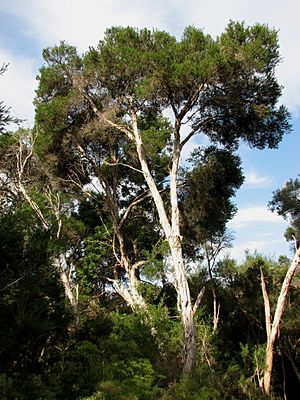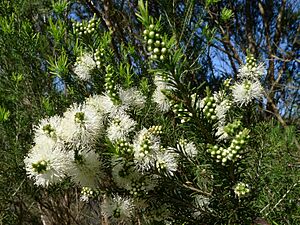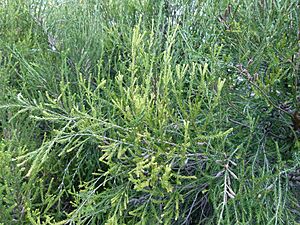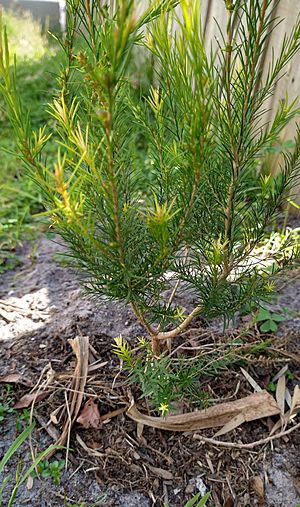Melaleuca ericifolia facts for kids
Quick facts for kids Swamp paperbark |
|
|---|---|
 |
|
| M. ericifolia at Mount Martha, Victoria | |
| Scientific classification | |
| Genus: |
Melaleuca
|
| Species: |
ericifolia
|
| Synonyms | |
|
|
The Melaleuca ericifolia, often called swamp paperbark, is a plant from the myrtle family. It grows naturally in south-eastern Australia. This plant can look a bit different from one place to another.
It often grows in wet, swampy areas. Sadly, when these swamps are drained or cleared for building, the number of these trees goes down. This has happened a lot around Port Philip Bay near Melbourne.
Contents
What Does it Look Like?
The swamp paperbark is usually a tall, thick shrub. Sometimes, it can grow into a small tree, reaching up to 9 metres (about 30 feet) tall. It has light-coloured, papery bark that can be white or brownish.
Its leaves are dark green and shaped like thin lines. They are about 5 to 18 millimetres (0.2 to 0.7 inches) long. The leaves are usually arranged in a way that looks like they are taking turns along the stem.
Flowers and Fruit
The flowers of the swamp paperbark are creamy-white. They grow in round clusters or spikes at the ends of the branches. These spikes can be up to 20 millimetres (0.8 inches) wide and 25 millimetres (1 inch) long. Each spike holds 10 to 40 individual flowers.
The flowers bloom from October to November in Australia. After the flowers, small, woody seed pods appear. These pods are like little capsules, about 2.5 to 3.6 millimetres (0.1 to 0.14 inches) long. They are arranged in long, cylinder shapes along the stems.
Plant Name and History
The scientific name Melaleuca ericifolia was first given to this plant in 1797. It was named by an English botanist named James Edward Smith.
The name ericifolia means "Erica-leaved." This is because the leaves of this plant look a bit like those of plants in the Erica family.
Where Does it Grow?
You can find the swamp paperbark in areas close to the coast in New South Wales, south of Port Macquarie. It also grows in Victoria, especially around Port Philip Bay. You can also see it on the islands in Bass Strait and along the coast of Tasmania.
It likes to grow next to streams and in coastal swamps. It can be found in areas with heath plants and in dry forests. As mentioned before, many of these plants have been lost in Victoria because swamps were drained and land was cleared.
Ecology
This melaleuca plant has flowers that smell nice. This sweet smell helps to attract birds, which then help to spread the plant's pollen.
The swamp paperbark is a "clonal species." This means it can grow new plants from its roots or stems, creating copies of itself. This ability is being used to help grow more of these plants in swampy areas that need to be restored.
Uses of the Swamp Paperbark
Traditional Uses
Aboriginal people have used the swamp paperbark for many things over a long time.
- The papery bark was used for paintings, for making blankets, and as roofing for their shelters.
- The strong wood was used to make tools like spears, clubs, and digging sticks.
- Oil from the leaves was used as medicine.
- The sweet nectar from the flowers was used to make tasty drinks.
Garden Uses
This plant is very tough and grows quickly. It makes a great screen plant for gardens. It can handle very wet soil, salty air from the coast, shady spots, and even some frost. You can also trim the plants to keep them smaller and neater.
Essential Oils
The leaves of the swamp paperbark contain special oils. These oils have been used in dental and medical products. They are also used to make scented soaps smell nice.
Other Uses
The leafy branches of this plant have been used to make fences. They are also used in aviaries (large bird cages) to provide nesting spots for birds like finches.
Images for kids





